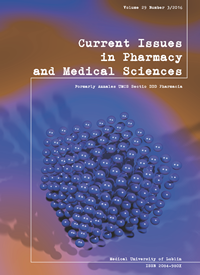The influence of 1.4-naphtoquinone derivative and of vitamin E on nitroso-oxidative processes in digestive organ mucous membranes under the conditions of cyclooxygenase blockage, and against the background of low intensity X-ray irradiation
DOI:
https://doi.org/10.1515/cipms-2016-0026Keywords:
nitroso-oxidative processes, derivative of 1.4.-naphtoquinone, digestive organs, X-ray irradiation, vitamin EAbstract
In recent years, the influence of chronic low intensity irradiation on the human body has increased. This is mediated not only by the consequences of technogenic catastrophies, but also due to application of radiation therapy of of radiation usage in industry. Hence, we investigated the influence of 1.4-naphtoquinone and vitamin Е on the nitroso-oxidative processes in the digestive organ mucous membranes, while affected by low intensity X-ray irradiation alone and in combination with the experimental blockage of COX, in rats. Our results show that X-ray irradiation of a total dose of 20 sGy during twenty days, induced an increase of the oxidative processes, as well as an increase in the activity of iNOS and myeloperoxidase in the mucous membranes of the stomach, small and large intestine. Both the effect of vitamin E and a 1.4-naphtoquinone derivative on the background of low intensity X-ray irradiation, and under the simultaneous effect of X-ray irradiation and COX blockage, brought about a decrease of the level of oxidative processes and of iNOS activity, whereas MPO activity increased. We also noted that the effect of vitamin E on the background of X-ray irradiation more significantly increased both the activity of SOD and catalase, when compared to the induced effect of the 1.4-naphtoquinone derivative. Under the conditions of COX-1/COX-2 blockage (as induced by way of indomethacin administration), against the background of X-ray irradiation, the content of TBA-active products (in the stomach and small intestine mucous membranes), the level of iNOS activity and the sum of nitrites and nitrates, were lower than that of independent effect. Тaking into account the prominent antioxidant and anti-inflammatory attributes of 1.4-naphtoquinone-3-[3-(3.5-di-tret-butyl-4-hydroxy-phenyl)-1.4-dihydronaphtalene-2-aminoil] butyrate, when compared to the effect of sole administration of vitamin E, both under the conditions of X-ray irradiation alone, and the simultaneous effect of X-ray irradiation and COX blockage, this derivative may be considered suitable as a perspective radiprotectant.
References
1.Akita S. Treatment of Radiation Injury. Adv. Wound Care (New Rochelle)., 3, 1, 2014.
2. Anwar M. et al.: Effect of antioxidant supplementation on digestive enzymes in radiation induced intestinal damage in rats. Int. J. Radiat. Biol., 89, 1061, 2013.
3. Boyde J. R., Rahmotullah M. Optimization of conditions for the colorimetric determination of citrulline, using diacethyl monoxim. Anal. Biochem., 107, 424, 1980.
4. Bradley P.P., Christensen R.D., Rothstein G. Cellular and extracellular myeloperoxidase in pyogenic inflammation. Blood.,
60, 618, 1982.
5. Brzozowski T. et al.: Role of prostaglandins in gastroprotection and gastric adaptation. J. Physiol. Pharmacol., 56, 33, 2005.
6. Charlier C., Michaux C. Dual inhibition of cyclooxygenase-2 (COX-2) and 5-lipoxygenase (5-LOX) as a new strategy to provide safer non – steroidal anti-inflammatory drugs. Eur. J. Med. Chem., 38, 645, 2003.
7. Datsyuk L.O. et al.: The effects of admibistration of nonselective inhibitor of NO-synthase under X-ray radiation. Studia Biologica, 3, 51, 2009.
8. Figurka О. М. et al.: Synthesis and features of 3-chloro-2-(3,5-di-tert-buthyl-4-hydroxyphenil)-1,4-naphtoquinones. Annals of National University “Lviv Polytechnic”. Chemistry, technology of compounds and their application, 787, 224, 2014.
9. Geyer J.W., Dabich D.: Rapid method for determination of arginase activity in tissue homogenates. Anal. Biochem., 39, 412, 1971.
10. Henni M., Ali D. Radiation induced side effects. Rev. Prat., 62, 461, 2012.
11. Hernández L. et al.: Aging and radiation: bad companions. Aging Cell., 14, 153, 2015.
12. Huang E.Y. et al.: Aminoguanidine alleviates radiation-induced small-bowel damage through its antioxidant effect. Int. J. Radiat. Oncol. Biol. Phys., 74, 237, 2009.
13. Kiselyk I.O. et al.: Peculiarities of the determination of nitrates and nitrites in peripheral blood in patients with viral hepatitis and in syndrome of jaundice of other aethiology. Laboratorna diagnostuka, 3, 43, 2001.
14. Liu L.N. et al.: Protective Role of Rheum Tanguticum Polysaccharide 1 in Radiation- induced Intestinal Mucosal Injury. Iran J. Pharm. Res., 14, 833, 2015.
15. Pisoschi A.M., Pop A.: The role of antioxidants in the chemistry of oxidative stress: A review. Eur. J. Med. Chem. 5, 55, 2015.
16. Sklyarov A.Y., Panasyuk N.B., Fomenko I.S. Role of nitric oxide-synthase and cyclooxygenase/lipooxygenase systems in development of experimental ulcerative colitis. J. Physiol. Pharmacol., 65, 62, 2011.
17. Stacey R., Green J.T.: Radiation-induced small bowel disease: latest developments and clinical guidance. Ther. Adv. Chronic. Dis., 5, 15, 2014.
18. Szumiel I.: Ionizing radiation-induced oxidative stress, epigenetic changes and genomic instability: the pivotal role of mitochondria. Int. J. Radiat. Biol., 91, 1, 2015.
19. Theis V.S. et al.: Chronic radiation enteritis. Clin Oncol (R. Coll. Radiol)., 22, 70, 2010.
20. Wallace J.L.: Prostaglandins, NSAIDs, and gastric mucosal protection: why doesn’t the stomach digest itself? Physiol. Rev., 88, 1547, 2008.
21. Yang C.S. et al.: Inhibition of inflammation and carcinogenesis in the lung and colon by tocopherols. Ann. N Y Acad. Sci., 1203, 29, 2010.
Downloads
Published
Issue
Section
License
Copyright (c) 2016 Authors

This work is licensed under a Creative Commons Attribution-NonCommercial-NoDerivatives 3.0 Unported License.


